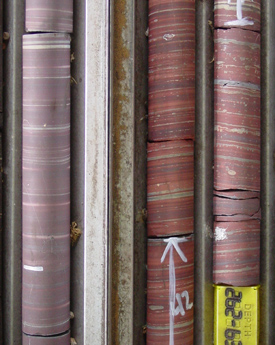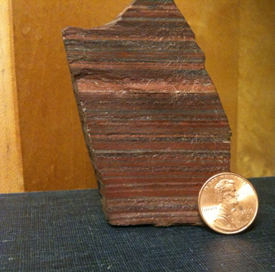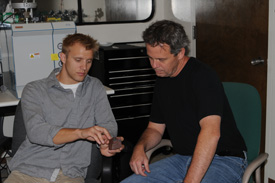
Geologist Noah Plavansky examines rocks deposited after a "Snowball Earth" glacial event. Image credit: Lyons Lab, UC-Riverside
*Spike in ancient marine phosphorus concentrations linked to emergence of complex life*
Biogeochemists have found new evidence linking “Snowball Earth” glacial events to the rise of early animals. The research was funded by the National Science Foundation (NSF).
Study results appear in this week’s issue of the journal Nature.
The controversial Snowball Earth hypothesis posits that, on several occasions, the Earth was covered from pole to pole by a thick sheet of ice lasting for millions of years.
These glaciations, the most severe in Earth history, occurred from 750 to 580 million years ago.
In the aftermath, the researchers discovered, the oceans were rich in phosphorus, a nutrient that controls the abundance of life in the oceans.
The team, led by scientists at the University of California Riverside, tracked phosphorus concentrations through Earth’s history by analyzing the composition of iron-rich chemical precipitates. These precipitates accumulated on the seafloor and “scavenged” phosphorus from seawater.

Drill core of sediments with iron formations used to track marine phosphorus concentrations. Image credit: Lyons Lab, UC-Riverside
The analyses revealed that there was a pronounced spike in marine phosphorus levels in the mid-Neoproterozoic (from ~750 to ~635 million years ago).
To explain these anomalously high concentrations, the researchers argue that the increase in erosion and chemical weathering on land that accompanied Snowball Earth glacial events led to the high amounts of phosphorus in the ocean.
The abundance of this nutrient, which is essential for life, in turn led to a spike in oxygen production via photosynthesis, according to Enriqueta Barrera, program director in the NSF’s Division of Earth Sciences, which funded the research.
The subsequent accumulation of oxygen in the atmosphere led to the emergence of complex life on Earth.
“In the geologic record, we found a signature for high marine phosphorus concentrations appearing in the immediate aftermath of Snowball Earth glacial events,” said Noah Planavsky, the first author of the research paper, and a graduate student at UC Riverside.
“Phosphorus ultimately limits net primary productivity on geological timescales,” said Plavansky. “High marine phosphorus levels would have facilitated a shift to a more oxygen-rich ocean-atmosphere system. This shift could have paved the way for the rise of animals and their ecological diversification.”
Planavsky explained the link between marine phosphorus concentrations and the levels of oxygen in the atmosphere.
“High phosphorus levels would have increased biological productivity in the ocean and the associated production of oxygen by photosynthesis,” he said.

Close-up of a sample of 2.7 billion-year-old iron formation from Zimbabwe; red is hematite. Image credit: Lyons Lab, UC-Riverside
Much of this organic matter is consumed, in turn, as a result of respiration reactions that also consume oxygen. However, the burial of some proportion of the organic matter results in a net increase of oxygen levels in the atmosphere.
Until now, scientists believed that geochemical conditions in the iron-rich ocean would have led to low phosphorus concentrations.
The researchers discovered no evidence of a phosphorus crisis after Snowball Earth glacial events, however, finding instead indications of an abundance of phosphorus.
“There are several known chemical fingerprints for increasing oxygen in the ocean and, by inference, in the atmosphere during the middle part of Neoproterozoic, and the rise of animals is an expected consequence,” said Timothy Lyons, a biogeochemist at UC Riverside and the senior investigator in the study.
“These results may be the first to capture the nutrient driver that was behind this major step in the history of life. That driver was ultimately tied to the extreme climate of the period.”

Scientists Noah Plavansky and Tim Lyons discuss attributes of a banded iron formation sample. Image credit: Lyons Lab, UC-Riverside
The scientists present data from some 700 individual samples of iron-oxide-rich rocks, which include new results as well as those obtained from a comprehensive survey of the literature.
Planavsky and Lyons were joined in the study by Christopher Reinhard of UC Riverside; Olivier J. Rouxel of the Woods Hole Oceanographic Institution; Andrey Bekker of the University of Manitoba, Canada; and Stefan V. Lalonde and Kurt O. Konhauser of the University of Alberta, Canada.
The research was also supported by grants from the NASA Astrobiology Institute and the NASA Exobiology Program.
*Source: National Science Foundation (NSF)
